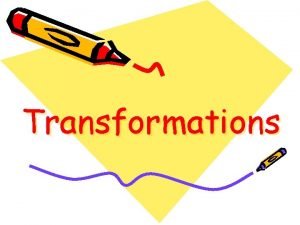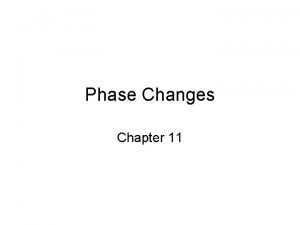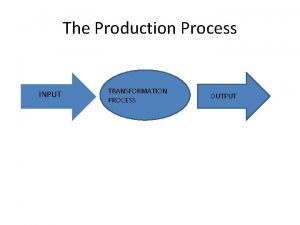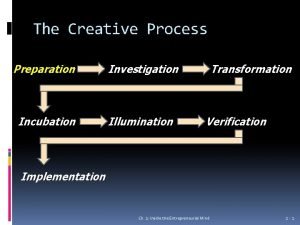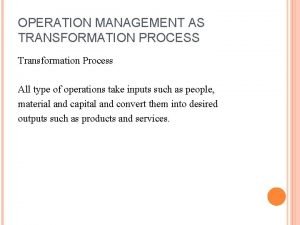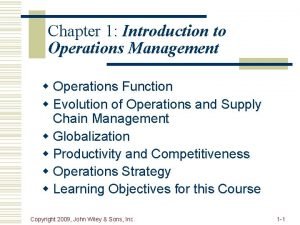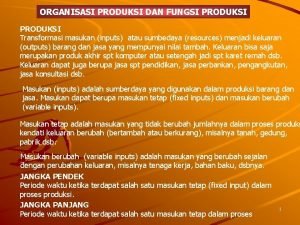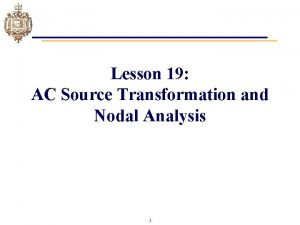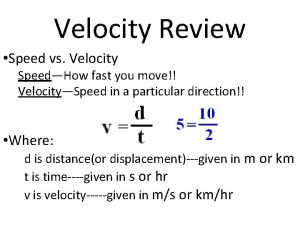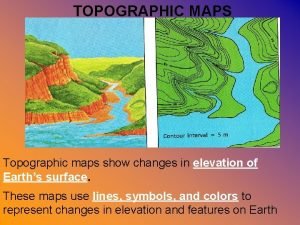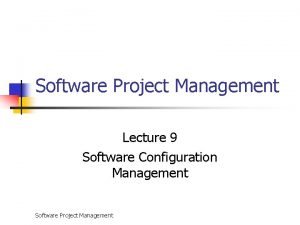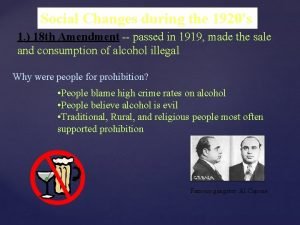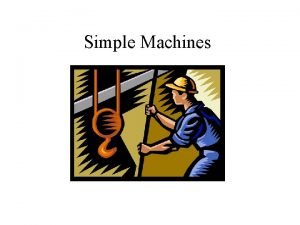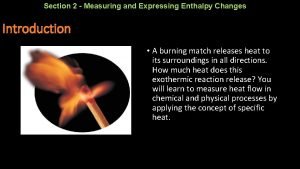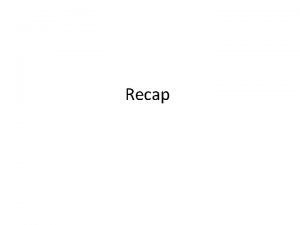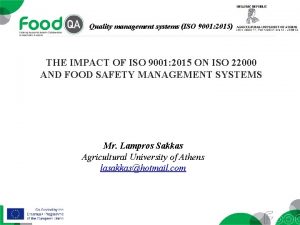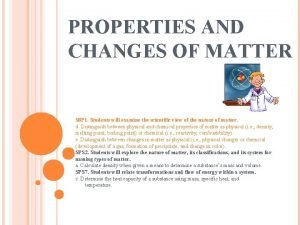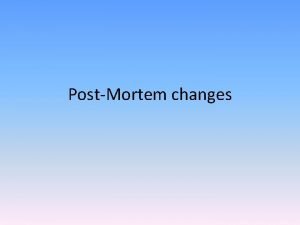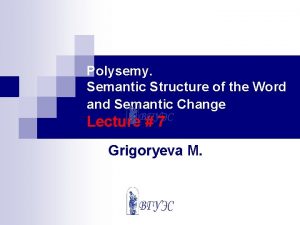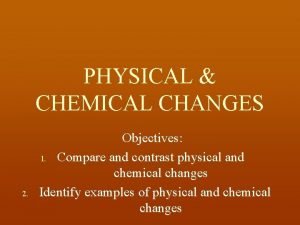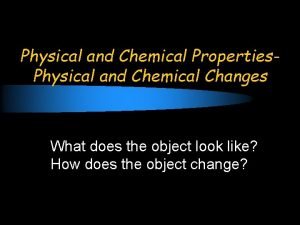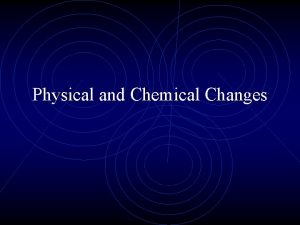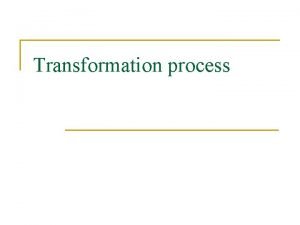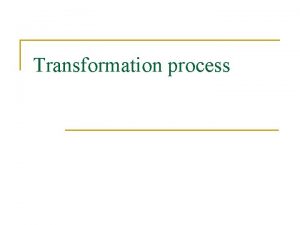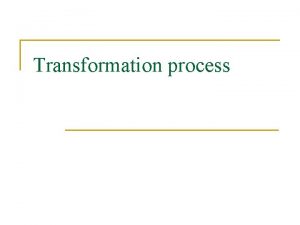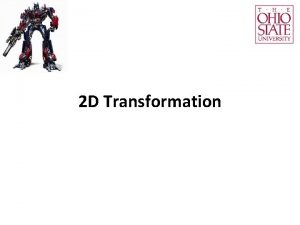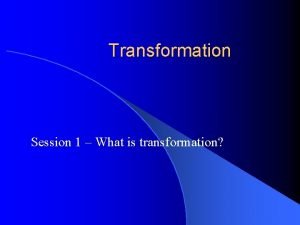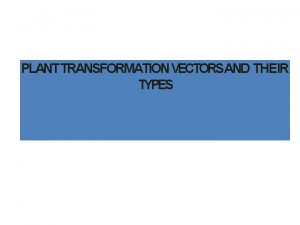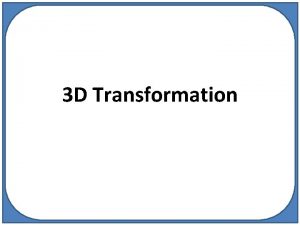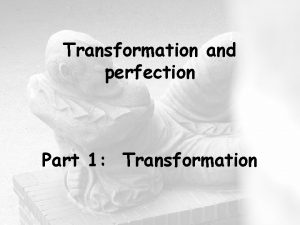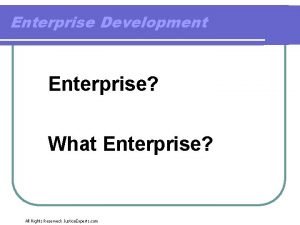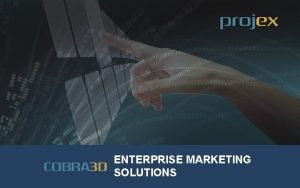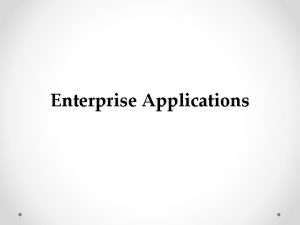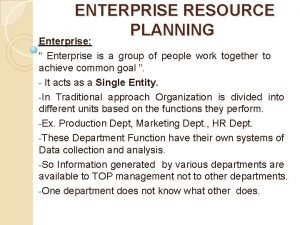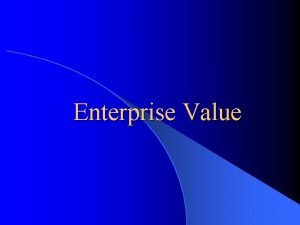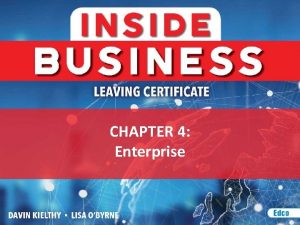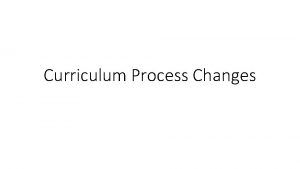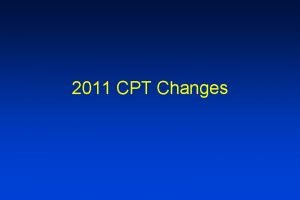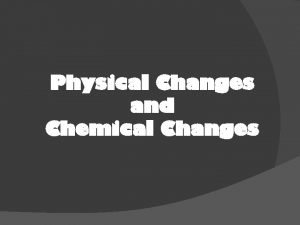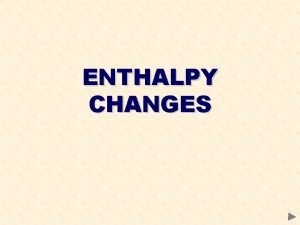The Process Enterprise How Process Transformation Changes the













































































- Slides: 77

The Process Enterprise: How Process Transformation Changes the Business Tom Coleman Chief Information and Process Officer Process Owner, Strategic Planning Sloan Valve Company ABPMP Chicago Chapter Meeting October 14, 2009 Sears Holding Corporation Hoffman Estates

Agenda l Sloan Overview l Strategic Focus l The Strategic Challenge l The Path to Change l The Results l The Impact l Q&A

Sloan Overview

Sloan Company Overview l l 103 year old company Privately held, mid-sized Mfr. of specialized plumbing products Systems: ü Business Suite ü Business Process Analysis 4

Major Sloan Locations l l l l Illinois (HQ, Design Center, Mfg, DC) China (Design Center, Mfg) Arkansas (Foundry) Massachusetts (Design Center, Mfg) Michigan (Design Center, Mfg) Mexico ( Mfg, DC) California (DC) Pennsylvania (DC) 5

Sloan Products 6

Strategic Focus

What Are We Trying To Do? ts se As ity uid How? le Liq ib What? ng Ta Cash A/R Inventory Equipment Property Goodwill Strategy and Process ad e bl gi se As Re n ta in es s In Human Capital Information Capital Organization Capital ts Adapted from: Kaplan and Norton 2004 8

Sample Strategic Planning Process Discovery Core Ideology • Core Values • Mission • Vision • BHAG What is our vision of today & the future? SWOT • SWOT What can we discover about the market, competitors, and ourselves? Value Plan Strategic Goals • Value Discipline • Value Prop (VP) • Financial • Customer • Process - Financial Val Prop - Customer Val Prop • Resource To achieve our vision how should we appear to our customers & stakeholders? How shall we achieve our financial and customer goals? Employee Performance Management • Functions • Teams • Individuals What must functions, teams, and individuals do? What resources do we need and how is our Readiness? 9

Sample Strategic Planning Process Discovery Core Ideology • Core Values • Mission • Vision • BHAG What is our vision of today & the future? SWOT • SWOT What can we discover about the market, competitors, and ourselves? Value Plan Strategic Goals • Value Discipline • Value Prop (VP) • Financial • Customer • Process - Financial Val Prop - Customer Val Prop • Resource To achieve our vision how should we appear to our customers & stakeholders? How shall we achieve our financial and customer goals? Employee Performance Management • Functions • Teams • Individuals What must functions, teams, and individuals do? What resources do we need and how is our Readiness? 10

Achieving Superior Performance Operational Effectiveness is Not Strategy Operational Effectiveness • Assimilating, attaining, and extending best practices Run the same races faster Value Discipline (Strategic Position) • Creating a unique and sustainable competitive position Choose to run a different race 11

Strategy is not only about ways to get better…more importantly, strategy formulation is about finding ways to get… different Source: Michael Porter 12

“Undifferentiated products and services allow the customer to capture most of the value. ” Michael Porter Author and Professor Harvard Business School 13

Value Discipline Low Cost Achieve the low cost position on products and services Solve the customer’s broader problem through differentiation Approach one: Broad market Approach two: Market segmentation Differentiation Adapted from: Michael Porter (1980) 14

Value Discipline Best Total Cost Achieve the low cost position on product and service support Solve the customer’s broader problem and share in the benefit Best Total Solution Adapted from: Michael Treacy and Fred Wiersema 1995 Build a better product for which customers will pay a premium Best Product Innovation 15

Value Discipline Best Total Cost Achieve the low cost position on product and service support Solve the customer’s broader problem and share in the benefit Build a better product for which customers will pay a premium Best Product Innovation Best Total Solution Lock-in Adapted from: Norton and Kaplan 2003/2004 16

Delta Model (Value Discipline) System Lock-in Proprietary Standard (Microsoft, Intel) Dominant Exchange (e. Bay) Horizontal Breadth (Fidelity) Total Customer Solutions Positioning Strategy Redefining the Customer Relationship (Saturn) Adapted from: Arnoldo Hax, MIT Sloan School of Management Low Cost (Southwest Airlines) Best Product Differentiation (Sony) 17

Strategy Vs Customer Value Attributes Michael Treacy and Fred Wiersema 18

Aligning Strategy to Processes = Meets general requirements Adapted from Kaplan and Norton 2001 / Treacy & Wiersema 1995 19

Sample Strategic Planning Process Discovery Core Ideology • Core Values • Mission • Vision • BHAG What is our vision of today & the future? SWOT • SWOT What can we discover about the market, competitors, and ourselves? Value Plan Strategic Goals • Value Discipline • Value Prop (VP) • Financial • Customer • Process - Financial Val Prop - Customer Val Prop • Resource To achieve our vision how should we appear to our customers & stakeholders? How shall we achieve our financial and customer goals? Employee Performance Management • Functions • Teams • Individuals What must functions, teams, and individuals do? What resources do we need and how is our Readiness? 20

Wheels of Competitive Strategy 1980 Mfg 2007 Mktg Finance Sales Goals Strategy Objectives Other Service Engineering HR 1980 Source: Michael E. Porter (Competitive Strategy) 2007 Source: T. Coleman 21

Strategic Focus Areas Customer Six focus areas (AKA “strategic themes”) Vision & Strategy Products & Services Supply Chain Information Capital & Technology F in a n c ia l R e s o u r c e s H u ma n R e s o u r c e s Note: Alfred Chandler: Structure follows strategy 22

Wheels of Competitive Strategy 1980 Mfg 2007 nc Fu Mktg Finance ns tio Sales Goals Strategy Objectives Other Service Engineering HR 1980 Source: Michael E. Porter (Competitive Strategy) 2007 Source: T. Coleman Customer Support Process Fu nc tio ns Fu nc tio Demand Generation Process Sloan Strategy and Goals ns Order To Cash Process New Product Development Process c n Fu 23 ns tio

Old Functions Vs Processes Marketing Sales Tech Support Mat Mgt Mfg QA Research Strategic Planning Demand Generation Order Acquisition Order-to-Cash Product Development & Lifecycle Mgt Cust Support Source-to-Pay Information Technology (IT) F in a n c e H u ma n R e s o u r c e s ( H R ) 24 Des Eng

New Functions Vs Processes Customer Relationships Supply Chain Product Dev & Lifecycle Mgt Strategic Planning Demand Generation Order Acquisition Order-to-Cash Product Development & Lifecycle Mgt (Domain Divided) Cust Support Source-to-Pay Information Technology & Process Mgt (IT & BPM) F i n a n c i a l C a p i t a l Mg t H u ma n R e s o u r c e M g t ( H R ) Note: Alfred Chandler: Structure follows strategy 25

EPO’s EPO New Functions Vs Processes EPO’s Customer Relationships Supply Chain Product Dev & Lifecycle Mgt Strategic Planning Demand Generation Order Acquisition Order-to-Cash Product Development & Lifecycle Mgt (Domain Divided) Cust Support Source-to-Pay Information Technology & Process Mgt (IT & BPM) F i n a n c i a l C a p i t a l Mg t H u ma n R e s o u r c e M g t ( H R ) 26

Mission and Vision The financial value proposition goals go here The customer value proposition goals go here The process goals go here The IT, HR, and the corporate enabling goals go here 27

Mission and Vision 28

Process Core Processes Belong Here (Not mere tasks/projects) 29

Strategic Planning Balanced Scorecard Matrix Enabling Theme: ____________ Executive Process Owner: ________ Objective Financial Perspective ROI Customer Perspective Customer Satisfaction Process Perspective KPI: OTC/STP Co. Q PCM: OTC Cycle Time Resource Perspective BPR OTC/STP Teams SAP SCM installed Hire SCM VP Measure Baseline 2007 Target 2008 Target 2009 Target 2010 Target 2011 Target 2012 EX AM PL E Scorecard Perspective Note: The Sloan slide is proprietary and has been substituted by this generic BSC Note: A real BSC is completely linked to the strategy map (strategic theme) 30 Responsible

Sample Strategic Planning Process Discovery Core Ideology • Core Values • Mission • Vision • BHAG What is our vision of today & the future? SWOT • SWOT What can we discover about the market, competitors, and ourselves? Value Plan Strategic Goals • Value Discipline • Value Prop (VP) • Financial • Customer • Process - Financial Val Prop - Customer Val Prop • Resource To achieve our vision how should we appear to our customers & stakeholders? How shall we achieve our financial and customer goals? Employee Performance Management • Functions • Teams • Individuals What must functions, teams, and individuals do? What resources do we need and how is our Readiness? 31

The Challenge 32

Strategic Order-to-Cash Goals 1. Develop avg. delivery from X days to X days 2. Improve inventory turnover from X turns to X Achieve X% perfect order performance Improve quality from X sigma to X sigma for OTC Improve DSO from X days to X days Develop a program to better transition of NPDI to OTC Develop a rigorous education and training program for OTC process performers Look for ways to change our operational practices to become more eco-friendly (lighting, packaging, and cradle-to-cradle program, etc. ) 3. 4. 5. 6. 7. 8. 33

h as -C -to t er Lis rd s l O lem ica b ct ro Ta P Terms today do not facilitate the timely receipt of cash. Credit policy consumes significant available OAP/OTC lead-time (e. g. , 1 day) - OAP. Possible lack of correlation between orders on credit hold and invoice collections which affects total customer lead-time. Mexico has different terms and they are informal with respect for handling (China? ). There is a disconnect between commission payouts and cash receipts Scrap process informal without ownership (reporting issue) Union contract a problem for perceived to-be vision for OTC (e. g. , Midwest DC @ FKP) Orders that have shipped and even delivered are not deemed to be closed today and may be modified Mixing of standard product and special orders (special finish) -- lead-time issue Customers return products without an RMA number Existence of obsolete or seldom used parts Wrong people making decisions affecting orders Invoicing problems associated with pricing, quality, quantity, expedited shipments. Inventory is not accurate. Weak handling of the returns sub-process of OTC. Reject Matl for Rework (RMR) is not followed Inaccurate bill of materials (BOM) Discipline is not uniformly applied (e. g. , union contract, other) Customer shipping errors unacceptable No perfect order performance tracking and metric. Lack of comprehensive under-standing about profits/benefits versus what it cost in OTC to do it (e. g. , old, low-volume product, etc. ). No global common metrics for OTC No global common reporting tool for OTC metrics Lack of variance analysis We have very limited automation for information processing (e. g. , bar-codes) China is not on SAP (e. g. , China) resulting in lack of information and synchronization. Due to WIP processing methods, scrap material cannot be processed in real-time A need for automated SAP processing for foundry scrap. Manually updating prices in Augusta every Monday morning (time consuming) No visibility of overseas items coming in or promise dates Manifests are manually intensive Manifests are sending only 9 tracking numbers back to SAP No integration between tracking numbers and handling units (weights, etc. ) Delivery processing is not real-time (post-goods issue: PGI) Customers are requiring detailing packing for advanced notification Innovation Communications problems within sites (e. g. , quality problems, production schedules). Communications problems with other Sloan sites (e. g. , quality problems, production schedules). Inventories build at times when large volume deliveries occur from China versus Ji. T. Substandard collaboration between Operations, Quality, and Customer Service Engineering changes -- lack of communication lines with all parties affected (including customers) Lack of communications with Credit on order handling plans Lack of understanding of who is responsible and accountable for information and resolution Each location's prod schedule is not synchronized for published lead-times (especially slow moving/non-stock and old parts) When demand exceeds supply, we keep promising the customer the same lead-time Lead-times are too long Accuracy of promise dates Lead-times are misrepresented to customers We don’ t ask customers what delivery dates they would like to have Lack of a quick change set up program to support OTC objectives Lack of product knowledge on the floor Lack of work instructions and training TQM principals are not being used in the process Need for continuing education and training to support continuous improvement. No corporate sales and operations planning for new and existing products. Lack of rough-cut capacity planning (resource requirements planning) No forecasting -- must anticipate long-lead items Not doing real forecasting to include integration with promos and supply chain No total productive maintenance system (TPM) Lack of statistical process controls (SPC) knowledge and controls. New product lead-times are such that orders go past due and are sold before OTC can fulfill. Lack of coordination of new products into OAP and OTC We take orders with standard lead-times for new products not available We don’ t know the customers requested delivery date; we may not deliver products timely to their need. Frequent problems having clean orders in OTC doesn’ t always know what the customer wants; it appears that the customer does not know what they want. PTP is not controlling purchase at the raw materials and S&OP level causing surplus inventory. No vendor mgt program (e. g. , receive product from vendors with wrong counts but not caught until too late) Vendors deliver materials late, creates shortages Raw material availability is a problem for certain commodities (AMI/substitutes) Purchase material shortages We cannot take a clean order and deliver it in four days ATO and 2 days MTS on average (or whatever the customer and competitive situations dictates). All product are promised to customers with the same lead-time. Collections/DSO/AR is not collecting ASAP (e. g. , disputes, terms vs. actual). Sloan does not have one face to the customer. Lack of order coordination driven into assembly/fulfillment. Lack of capacity planning (CRP) Kanban/QR levels not dynamically set based on S&OP plans and OTC constraints Kanban/QR use needs to be re-reviewed to meet strategic plan Expedited customer orders adversely affect other previously promised orders. Multiple shipping locations -- customer gets multiple shipments Customer returns material and we lose it Too many materials shortages Finished good inventory strategies lacking that prevent complete shipments Inaccurate promise dates cause us to spend a lot of money on expedited shipments; no way of calculating accurate promise delivery dates The returns goods process at all locations is inadequate Lack of supply management MTS items intended for DC are sent to regular customers instead Too much rework No way to verify customer claims about order inaccuracies We take orders with standard lead-times for products under revision (ECM) not available Length of time for documentation to get through the system (MDM, cost of products, BOM's) Process Change Mgt in shop not engaged Lack of product lifecycle mgt (discontinuations, end-of-life, product rationalization). Tool Mgt System (is not used as part of a solution) 34

Order-to-Cash KPI Benchmarks OTC Metric Laggard* Avg* BIC* Sloan ’ 07 81% 88% 95% X% A. Orders in Compliance to quality 85% 94% 98% X% B. Orders complete/on-time 89% 91% 96% X% C. Orders with correct doc 89% 91% 96% X% Finished Goods Inventory turns 3 turns 13 turns 28 turns X turns Inventory costs as share of revenue 30% ($76 M) 14% ($35 M) 5% ($12 M) X% ($X M) Quality 1. 81 σ ($XM) 3. 68 σ ($XM) 5. 04 σ ($XM) Xσ ($XM) * * * X to X days Perfect Order Performance Order-to-cash cycle time * Aberdeen 35

Order-to-Cash PCM Benchmarks OTC Metric Laggard* Avg* BIC* Sloan ’ 07 81% 97% X% (FG) 62. 2% 98. 6% 99. 9% X% 382, 000 13, 000 200 X 68% 84% 93% X% Productivity at Constraint Work Centers - - - X% Efficiency at Constrain Work Centers - - - X% Utilization of Direct Labor 61% 74% 88% X% Manufacturing Schedule Compliance 75% 88% 95% X% Logistics Costs as % of Sales 20% 14% 5% X% Inventory Record Accuracy (not $) First Pass Yield Defects per Mil. Opportunities (DPMO) Overall Equipment Effectiveness * Tolerances used to calculate accuracy vary widely and do not comply with APICS recommended best practices or best practice cycle count policies * Aberdeen 36

The Path

Gartner defines BPM as a management discipline that treats processes as assets that directly contribute to enterprise performance by driving operational excellence and business agility. What’s wrong with this?

BPM is a management discipline that treats processes as assets that directly drive enterprise performance through operational excellence, business agility, and strategic differentiation.

Process Enterprise “An enterprise in which all work is thought of, designed, performed, and managed as process work by everyone” Sloan 2002

Process Definition “An organized group of related tasks that work together to create value for customers. ” -end A“ Source: Michael Hammer -to d n e s i ” P ss e c ro 41

Process Direction at Sloan 1. 2. 3. 4. 5. 6. 7. 8. 9. 10. Easy To Do Business With (ETDBW) Focus on customers and outcomes Define goals in customer terms Use metrics for improving, not just accounting Form a collaborative, team-based organization Embrace a vision beyond enterprise boundaries See work and design work in end-to-end terms (governance, core, and enabling processes) Continuously learn Think outside the box Focus beyond improvement to design Source concepts adapted from The Agenda (Dr. Michael Hammer) 42

Sloan Enterprise Process Model SPP Strategic Planning Process Strategic Process Governance Processes EPM Employee Performance Mgt Process BPP Business Planning Process AOP Annual Oper Plan Process QAP Quality Assurance Process S&OP Sales & Oper Planning Process Core Processes DGP Demand Generation Process OAP Order Acquisition Process OTC Order-to-Cash Process CSP Customer Support Process NPD New Product Development Process MDM Master Data Mgt Process ECM Engineering Change Mgt Process PCM Shop Process Change Mgt Process STP Source-to-Pay Process BPM Business Process Mgt Process Enabling Processes 43

Sloan Enterprise Process Model SPP Strategic Planning Process Strategic Process Governance Processes EPM Employee Performance Mgt Process BPP Business Planning Process AOP Annual Oper Plan Process QAP Quality Assurance Process S&OP Sales & Oper Planning Process Core Processes DGP Demand Generation Process OAP Order Acquisition Process OTC Order-to-Cash Process CSP Customer Support Process NPD New Product Development Process MDM Master Data Mgt Process ECM Engineering Change Mgt Process PCM Shop Process Change Mgt Process STP Source-to-Pay Process BPM Business Process Mgt Process Enabling Processes 44

Sloan Enterprise Process Model SPP Strategic Planning Process Strategic Process Governance Processes EPM Employee Performance Mgt Process BPP Business Planning Process AOP Annual Oper Plan Process QAP Quality Assurance Process S&OP Sales & Oper Planning Process Core Processes DGP Demand Generation Process OAP Order Acquisition Process OTC Order-to-Cash Process CSP Customer Support Process NPD New Product Development Process MDM Master Data Mgt Process ECM Engineering Change Mgt Process PCM Shop Process Change Mgt Process STP Source-to-Pay Process BPM Business Process Mgt Process Enabling Processes 45

Sloan Enterprise Process Model SPP Strategic Planning Process Strategic Process 2007 Governance Processes EPM Employee Performance Mgt Process BPP Business Planning Process Core Processes DGP Demand Generation Process OAP Order Acquisition Process 2004 Enabling Processes (many more) MDM Master Data Mgt Process 2009 2004 ECM Engineering Change Mgt Process AOP Annual Oper Plan Process 2009 OTC Order-to-Cash Process WIP PCM Shop Process Change Mgt Process 2005 2008 QAP Quality Assurance Process 2008 CSP Customer Support Process WIP S&OP Sales & Oper Planning Process 2006 2007 NPD New Product Development Process WIP 2003 STP Source-to-Pay Process BPM Business Process Mgt Processes 46

Pillars of Strategic Focus – Core Focus Customer Focus Supply Chain Focus Products Main Processes Demand Generation Order Acquisition Customer Support Main Process Order-to-Cash Source-to-Pay Main Processes New Product Dev Engineering Change Mgt Master Data Mgt Main System CRM, SD Main System SCM, MM, PP Main System PLM, BOM, CAD Functional Dept Business Development Functional Dept Supply Chain Operations Functional Dept Research & Development KPI’s Revenue Market Share DGP/OAP/CSP Cycle Time Customer Response Index CSP Call Abandon Rate Sales Forecast Accuracy DSO (with CFO) KPI’s Perfect Order Perf. Cost of Quality Sigma Performance Inventory Turnover Cost of Goods Sold OTC/STP cycle times DPO (w/CFO) KPI’s Time-to-Market Project Delivery Perf Project Budget Perf New Product Gap (w/BD) Innovation Rate (w/BD

Pillars of Strategic Focus – Enabling Focus Business Technology Main Processes BPM, BPR, CI IT Dev/Ops Main System BPM, Net. Weaver Functional Dept Business Technology (IT) KPI’s Project On-time Perf Project Budget Perf IT budget as % Sales Customer Response Index SLA Compliance Process KPI Achievement Focus Human Capital Focus Financial Capital Main Process Performance Mgt Change Mgt Main Processes Business Planning Risk Mgt Main System HCM Main System SEM, FI, CO Functional Dept HR Functional Dept Finance KPI’s Revenue Per Employee Job Satisfaction Index Training $ Vs Budget Employee Turnover Recruitment Cycle Time Recruitment Costs EPM Compliance KPI’s DSO (w/BD) DPO (w/SCO) Cash Mgt Vs Revenue What else?

Sloan Process Governance Organization Strategic Planning Process Lifecycle Mgt Process Business Process Redesign Process Sustaining Improvement Process Lifecycle Mgt Process Business Process Redesign Process (BPR) Sustaining Improvement Process (SI) Process Team A Order-to-Cash Process Executive Committee (Process Council) Chief Process Officer (CPO) Executive Process Owner (EPO) Process Transformation Facilitator Process Owner (PO) Process Team B Process Team C Demand Generation Process Customer Processes Supply Chain Processes Product Dev Processes HCM Processes ICM Process FCM Processes Demand Generation Process Order-to-Cash Process New Product Dev Process Employee Perf Mgt Process Systems Dev Process Budgeting Process Etc. Global Quality Assurance Process 49

Sloan Process Governance Organization Strategic Planning Process Lifecycle Mgt Process Business Process Redesign Process Sustaining Improvement Process Lifecycle Mgt Process Business Process Redesign Process (BPR) Sustaining Improvement Process (SI) Process Team A Order-to-Cash Process Executive Committee (Process Council) Chief Process Officer (CPO) Executive Process Owner (EPO) Process Transformation Facilitator Process Owner (PO) Process Team B Process Team C Demand Generation Process Customer Processes Supply Chain Processes Product Dev Processes HCM Processes ICM Process FCM Processes Demand Generation Process Order-to-Cash Process New Product Dev Process Employee Perf Mgt Process Systems Dev Process Budgeting Process Etc. Global Quality Assurance Process 50

Sloan Process Governance Organization Strategic Planning Process Lifecycle Mgt Process Business Process Redesign Process Sustaining Improvement Process Lifecycle Mgt Process Business Process Redesign Process (BPR) Sustaining Improvement Process (SI) Process Team A Order-to-Cash Process Executive Committee (Process Council) Chief Process Officer (CPO) Executive Process Owner (EPO) Process Transformation Facilitator Process Owner (PO) Process Team B Process Team C Demand Generation Process Customer Processes Supply Chain Processes Product Dev Processes HCM Processes ICM Process FCM Processes Demand Generation Process Order-to-Cash Process New Product Dev Process Employee Perf Mgt Process Systems Dev Process Budgeting Process Etc. Global Quality Assurance Process 51

Sloan Process Governance Organization Strategic Planning Process Lifecycle Mgt Process Business Process Redesign Process Sustaining Improvement Process Lifecycle Mgt Process Business Process Redesign Process (BPR) Sustaining Improvement Process (SI) Process Team A Order-to-Cash Process Executive Committee (Process Council) Chief Process Officer (CPO) Executive Process Owner (EPO) Process Transformation Facilitator Process Owner (PO) Process Team B Process Team C Demand Generation Process Customer Processes Supply Chain Processes Product Dev Processes HCM Processes ICM Process FCM Processes Demand Generation Process Order-to-Cash Process New Product Dev Process Employee Perf Mgt Process Systems Dev Process Budgeting Process Etc. Global Quality Assurance Process 52

The Proliferation of Change Initiatives and Programs So. PK C S B Reengineering M& A 53

l TOC: Theory of Constraints (Goldratt) ü ü l Lean (Toyota TPS, Womack & Jones) ü l Manage the 7 wastes, pull system, cycle time (takt), autonomation, 5 S, … 6σ : Six Sigma (Motorola) ü ü ü l Manage constraints (bottlenecks) in a process Identify, exploit, subordinate, elevate, … Manage defects, reduce variation in a process Statistical methods DMAIC, DMADV/DFSS So. PK: System of Profound Knowledge (Deming) Knowledge of variation, systems thinking, knowledge/learning, motivation An understanding that all the parts of a business are related in such a way that if you focus on optimizing one part, other parts may suffer ü Plan, do, check, act (PDCA) ü ü l BPR: Business Process Reengineering (Hammer) Fundamental rethinking & radical redesign of business processes to achieve dramatic improvements in critical, contemporary measures of performance such as cost, quality, speed, & service 54 ü Design/re-design methodology ü

Business Process Management (Process Lifecycle Mgt) ea re su re M ea r& asu Me on ito Pro ces s Im pro vem ent & ion t a t en m ple m I e ss c o Pr M M ito r& re su ea M M on r& ito on su re M n ig es D s es oc Pr or nit Mo BPM 55

Business Process Lifecycle Sustaining Improvement IMPROVEMENT Process Redesign Sustaining Improvement E Process Redesign E V I IT N A V AD G TA T PE M CO Sustaining Improvement New Design A. Tenner & I. De. Toro TIME 56

Business Process Management (BPM) Process Redesign Process Governance Process Improvement Business Process Redesign Process Sustaining Improvement Processes Similar Names: Kaikaku Business Process Reengineering Radical Improvement DMADV: Define, Measure, Analyze, Design, Verify (DFSS) Similar Names: Kaizen Continuous Improvement (CI) Incremental Improvement (II) Plan, Do, Check, Act (PDCA) DMAIC: Define, Measure, Analyze, Improve, Control 57

LEVEL 0 DIAGRAM VERSION 58

Continuous Improvement Process (Incremental and Sustaining Improvement) From BPM Process Define Problem Ad hoc Improvement Measure Problem Analyze Problem Improve Control DMAIC (also TOC, Lean, …) LEVEL 1 DIAGRAM VERSION 59

Sloan Lesson Outbound Logistics Sub-process Engineering Chg Mgt Order-to-Cash Order Acquisition Master Data Mgt Plant Maintenance Employee Perf Mgt Customer Support Strategic Planning New Product Dev Procure-to-Pay Sourcing Business Process Mgt Demand Generation 60

Sloan Lesson Outbound Logistics Sub-process 12 Processes 6 Sub-processes each (avg. ) 72 sub-processes -----------------------5 months dev each (avg. ) -----------------------360 month effort (1 team) 30 years of work (1 team) Engineering Chg Mgt Order-to-Cash Order Acquisition Master Data Mgt Plant Maintenance Employee Perf Mgt Customer Support Strategic Planning New Product Dev Procure-to-Pay Sourcing Business Process Mgt Demand Generation 61

LEVEL 0 DIAGRAM VERSION 62

Sloan Business Transformation Process (Business Process Design/Redesign) BPR Symptoms, diagnosis, cure Also DMADV/DFSS… 63

Sloan Levers of Transformation l l l Integrated with Sloan’s Strategic Plan Process Redesign as well as Improvement Policies, Rules, Procedures Computing & Technology Organization Structure Change Management Roles & Job Changes Paradigm Shifts Communications Knowledge Facilities 64

Results

OTC As-Is Process 21 5 1 = 4 s = s ane e L i it m v i i t w c S t. A c. n 1 i ist 37 D = G U 2. 7 A 6 2 P= K F 37 = M D 43 S = s! r T e b W V m S u 1 n 3 e = g r N - W ffs = La o d n a H 3. 66

OTC To-Be Main Process 67

h as -C -to t er Lis rd s l O lem ica b ct ro Ta P Terms today do not facilitate the timely receipt of cash. Credit policy consumes significant available OAP/OTC lead-time (e. g. , 1 day) - OAP. Possible lack of correlation between orders on credit hold and invoice collections which affects total customer lead-time. Mexico has different terms and they are informal with respect for handling (China? ). There is a disconnect between commission payouts and cash receipts Scrap process informal without ownership (reporting issue) Union contract a problem for perceived to-be vision for OTC (e. g. , Midwest DC @ FKP) Orders that have shipped and even delivered are not deemed to be closed today and may be modified Mixing of standard product and special orders (special finish) -- lead-time issue Customers return products without an RMA number Existence of obsolete or seldom used parts Wrong people making decisions affecting orders Invoicing problems associated with pricing, quality, quantity, expedited shipments. Inventory is not accurate. Weak handling of the returns sub-process of OTC. Reject Matl for Rework (RMR) is not followed Inaccurate bill of materials (BOM) Discipline is not uniformly applied (e. g. , union contract, other) Customer shipping errors unacceptable No perfect order performance tracking and metric. Lack of comprehensive under-standing about profits/benefits versus what it cost in OTC to do it (e. g. , old, low-volume product, etc. ). No global common metrics for OTC No global common reporting tool for OTC metrics Lack of variance analysis We have very limited automation for information processing (e. g. , bar-codes) China is not on SAP (e. g. , China) resulting in lack of information and synchronization. Due to WIP processing methods, scrap material cannot be processed in real-time A need for automated SAP processing for foundry scrap. Manually updating prices in Augusta every Monday morning (time consuming) No visibility of overseas items coming in or promise dates Manifests are manually intensive Manifests are sending only 9 tracking numbers back to SAP No integration between tracking numbers and handling units (weights, etc. ) Delivery processing is not real-time (post-goods issue: PGI) Customers are requiring detailing packing for advanced notification Innovation Communications problems within sites (e. g. , quality problems, production schedules). Communications problems with other Sloan sites (e. g. , quality problems, production schedules). Inventories build at times when large volume deliveries occur from China versus Ji. T. Substandard collaboration between Operations, Quality, and Customer Service Engineering changes -- lack of communication lines with all parties affected (including customers) Lack of communications with Credit on order handling plans Lack of understanding of who is responsible and accountable for information and resolution Each location's prod schedule is not synchronized for published lead-times (especially slow moving/non-stock and old parts) When demand exceeds supply, we keep promising the customer the same lead-time Lead-times are too long Accuracy of promise dates Lead-times are misrepresented to customers We don’ t ask customers what delivery dates they would like to have Lack of a quick change set up program to support OTC objectives Lack of product knowledge on the floor Lack of work instructions and training TQM principals are not being used in the process Need for continuing education and training to support continuous improvement. No corporate sales and operations planning for new and existing products. Lack of rough-cut capacity planning (resource requirements planning) No forecasting -- must anticipate long-lead items Not doing real forecasting to include integration with promos and supply chain No total productive maintenance system (TPM) Lack of statistical process controls (SPC) knowledge and controls. New product lead-times are such that orders go past due and are sold before OTC can fulfill. Lack of coordination of new products into OAP and OTC We take orders with standard lead-times for new products not available We don’ t know the customers requested delivery date; we may not deliver products timely to their need. Frequent problems having clean orders in OTC doesn’ t always know what the customer wants; it appears that the customer does not know what they want. PTP is not controlling purchase at the raw materials and S&OP level causing surplus inventory. No vendor mgt program (e. g. , receive product from vendors with wrong counts but not caught until too late) Vendors deliver materials late, creates shortages Raw material availability is a problem for certain commodities (AMI/substitutes) Purchase material shortages We cannot take a clean order and deliver it in four days ATO and 2 days MTS on average (or whatever the customer and competitive situations dictates). All product are promised to customers with the same lead-time. Collections/DSO/AR is not collecting ASAP (e. g. , disputes, terms vs. actual). Sloan does not have one face to the customer. Lack of order coordination driven into assembly/fulfillment. Lack of capacity planning (CRP) Kanban/QR levels not dynamically set based on S&OP plans and OTC constraints Kanban/QR use needs to be re-reviewed to meet strategic plan Expedited customer orders adversely affect other previously promised orders. Multiple shipping locations -- customer gets multiple shipments Customer returns material and we lose it Too many materials shortages Finished good inventory strategies lacking that prevent complete shipments Inaccurate promise dates cause us to spend a lot of money on expedited shipments; no way of calculating accurate promise delivery dates The returns goods process at all locations is inadequate Lack of supply management MTS items intended for DC are sent to regular customers instead Too much rework No way to verify customer claims about order inaccuracies We take orders with standard lead-times for products under revision (ECM) not available Length of time for documentation to get through the system (MDM, cost of products, BOM's) Process Change Mgt in shop not engaged Lack of product lifecycle mgt (discontinuations, end-of-life, product rationalization). Tool Mgt System (is not used as part of a solution) 68

Weaknesses In The As-Is 1. 2. 3. 4. 5. 6. 7. 8. 9. 10. 11. 12. 13. 14. 15. 16. 17. 18. 19. 20. 21. 22. 23. 24. 25. 26. 27. 28. 29. 30. 31. 32. 33. Commitments are made by Sloan to deliver products to customers without systematic consideration of the customer’ s desired delivery requirements Commitments are made to deliver products to customers without consideration for product availability, capacity, or actual product lead-time Other processes contaminate OTC with bad data (e. g. , Inaccurate information on sales orders causes incomplete or wrong pricing requiring a debit process to occur at time of payment) OTC has clean-up processes to make up for ongoing discipline and transaction quality problems (e. g. , discrepancy-based process cycle counting; Rejected Material for Rework [RMR]; scrap and reclaim process; Return Materials Authorization [RMA]) Lack of process documentation Lack of OTC process controls (e. g. , statistical process control [SPC]; capacity planning; Design for Manufacturability [DFM]) Too many steps needed to correct for inherent inaccuracies in the process (e. g. , inventory adjust. ) Orders flow for inactive or internal products (FD) Due to our highly variable product configurations, we lack repetitive production focus in some factories and in the supply chain There is a dependence on manual expediting to make up for a deficient process (e. g. , 9: 00) Planning cycles and other transactions are sometimes weekly rather than daily (e. g. , In WN MRP runs weekly, PGI is daily) Multiple product variations and old/obsolete products make it difficult to be able to offer all products within std lead times Our distribution strategy does not support our corporate strategy Planning cycles and other transactions are sometimes weekly rather than daily (e. g. , In WN MRP runs weekly, PGI is daily) The process lacks the ability to utilize a forecast for demand planning and a production plan for operations planning OTC is reactive rather than proactive (e. g. , trying to inspect quality in Vs quality-at-the-source) Kanban (QR) levels are not planned and reviewed on a regular basis nor are they always used properly Commitments are made to deliver products to customers without an on-going consideration real costs and true product profitability There is no global inventory management and control structure and related policies Payment terms cause poor order flows in FKP for the factory, D/C, and collections processing Kanban (QR) levels are not planned and reviewed on a regular basis for appropriate quantities We negotiate an additional discount for customers with problems paying without ramifications Sloan entities are not viewed as parts of a global Sloan supply chain OTC does not mandate global coordination, communication, facilitation, and focused leadership Mgt has historically been undisciplined and informal We use one process to make another process work (e. g. , credit processing Vs collections; cycle counting Vs inventory control) There is poor utilization of other processes to help OTC (e. g. , statistical process control [SPC], quick change methods, P 2 P) Sub processes within OAP and OTC are poorly mixed. (e. g. , It appears we use the credit group at the time of new order credit processing for enforcement of collections rather than have a process that enforces credit as a part of a collection sub process). Missing policies that determine who makes decisions about what products are saleable While Sloan has a premier business system, SAP, there is a lack of automation throughout the process (e. g. , reporting [BI], bar-coding, costing, etc. ) The way SAP is configured in some areas, it is difficult to automate certain metrics consistent with BIC (e. g. , sales order performance) There is no process or automated linkage from Sloan entities to Sloan suppliers There are poor automated linkages to customers. EDI linkages are minimal and they are suspect for poor quality. ISA linkages use manual entry of data the old fashioned way – by hand. There is no use of vendor managed inventory (VMI). 69

70

71

72

73

74

Sample Sloan Process Results l Strategic Planning Process (SPP) ü l Employee Performance Mgt (EPM) ü l ID sigma/COQ levels; formal methods/processes (e. g. , DMAIC) Master Data Mgt (MDM) ü l Automate pricing/approvals; reworked credit process; to be reorg. Quality Assurance Process (QAP) ü l Silos to breakthrough “tiger team” development with gates; ideation Order Acquisition Process (OAP) ü l XX% call abandon rate reduced to X% New Product Development (NPD) ü l SPP driven goals & appraisal throughout the company Customer Support Process (CSP) ü l Product strategy to a full mgt process with the BSC 3. 7 day SAP MDM loads to <3 hour MDM loads Engineering Change Mgt (ECM) ü Everything goes mentality to ECO business case analysis 75

1. 2. 3. 4. 5. 6. 7. 8. 9. 10. 11. 12. 13. How Does Process Transformation Change the Business? Focus is on strategic differentiation not just oper. excellence The strategy process drives structure Strategy and structure drive process, resources, & metrics Methods are clear: Zoom in to improve / zoom out to design Design work is end-to-end work Cross-functional “process” teams are the best teams For transformation, engage all the levers of holistic change The role of top management shifts to EPO responsibilities The role of middle management shifts to coaching BPM engages learning & growth during process design IT, HR, and Finance become enabling groups for core areas Process design sets the stage for business model innovation You don’t implement systems; you implement processes 76

Thank you!
 Changes in latitudes, changes in attitudes meaning
Changes in latitudes, changes in attitudes meaning Examples of physical change
Examples of physical change Change in position or size
Change in position or size Putting the enterprise into the enterprise system
Putting the enterprise into the enterprise system Enterprise
Enterprise Is vaporization endothermic or exothermic
Is vaporization endothermic or exothermic What is the input–transformation–output process?
What is the input–transformation–output process? Transformation in creative process
Transformation in creative process The transformation process in operations management
The transformation process in operations management Transformation process model in operations management
Transformation process model in operations management Operations management transformation process
Operations management transformation process Organisasi produksi
Organisasi produksi Nodal analysis
Nodal analysis Hát kết hợp bộ gõ cơ thể
Hát kết hợp bộ gõ cơ thể Frameset trong html5
Frameset trong html5 Bổ thể
Bổ thể Tỉ lệ cơ thể trẻ em
Tỉ lệ cơ thể trẻ em Chó sói
Chó sói Tư thế worm breton là gì
Tư thế worm breton là gì Hát lên người ơi alleluia
Hát lên người ơi alleluia Các môn thể thao bắt đầu bằng tiếng đua
Các môn thể thao bắt đầu bằng tiếng đua Thế nào là hệ số cao nhất
Thế nào là hệ số cao nhất Các châu lục và đại dương trên thế giới
Các châu lục và đại dương trên thế giới Cong thức tính động năng
Cong thức tính động năng Trời xanh đây là của chúng ta thể thơ
Trời xanh đây là của chúng ta thể thơ Mật thư tọa độ 5x5
Mật thư tọa độ 5x5 Làm thế nào để 102-1=99
Làm thế nào để 102-1=99 Phản ứng thế ankan
Phản ứng thế ankan Các châu lục và đại dương trên thế giới
Các châu lục và đại dương trên thế giới Thơ thất ngôn tứ tuyệt đường luật
Thơ thất ngôn tứ tuyệt đường luật Quá trình desamine hóa có thể tạo ra
Quá trình desamine hóa có thể tạo ra Một số thể thơ truyền thống
Một số thể thơ truyền thống Cái miệng nó xinh thế chỉ nói điều hay thôi
Cái miệng nó xinh thế chỉ nói điều hay thôi Vẽ hình chiếu vuông góc của vật thể sau
Vẽ hình chiếu vuông góc của vật thể sau Biện pháp chống mỏi cơ
Biện pháp chống mỏi cơ đặc điểm cơ thể của người tối cổ
đặc điểm cơ thể của người tối cổ V cc cc
V cc cc Vẽ hình chiếu đứng bằng cạnh của vật thể
Vẽ hình chiếu đứng bằng cạnh của vật thể Vẽ hình chiếu vuông góc của vật thể sau
Vẽ hình chiếu vuông góc của vật thể sau Thẻ vin
Thẻ vin đại từ thay thế
đại từ thay thế điện thế nghỉ
điện thế nghỉ Tư thế ngồi viết
Tư thế ngồi viết Diễn thế sinh thái là
Diễn thế sinh thái là Các loại đột biến cấu trúc nhiễm sắc thể
Các loại đột biến cấu trúc nhiễm sắc thể Thế nào là số nguyên tố
Thế nào là số nguyên tố Tư thế ngồi viết
Tư thế ngồi viết Lời thề hippocrates
Lời thề hippocrates Thiếu nhi thế giới liên hoan
Thiếu nhi thế giới liên hoan ưu thế lai là gì
ưu thế lai là gì Hổ sinh sản vào mùa nào
Hổ sinh sản vào mùa nào Khi nào hổ mẹ dạy hổ con săn mồi
Khi nào hổ mẹ dạy hổ con săn mồi Hệ hô hấp
Hệ hô hấp Từ ngữ thể hiện lòng nhân hậu
Từ ngữ thể hiện lòng nhân hậu Thế nào là mạng điện lắp đặt kiểu nổi
Thế nào là mạng điện lắp đặt kiểu nổi Www.tabgold.co.za horse results today
Www.tabgold.co.za horse results today Constant velocity graph
Constant velocity graph Maps that show changes in elevation of earth's surface
Maps that show changes in elevation of earth's surface Resurrection changes everything
Resurrection changes everything Physical changes of old age
Physical changes of old age Pixl knowit gcse chemistry quantitative
Pixl knowit gcse chemistry quantitative Types of software changes
Types of software changes Social changes in the 1920s
Social changes in the 1920s What kind of simple machine is a fishing pole
What kind of simple machine is a fishing pole Measuring and expressing enthalpy changes
Measuring and expressing enthalpy changes Changes in an individual's behavior arising from experience
Changes in an individual's behavior arising from experience Major changes in iso 9001 for 2015
Major changes in iso 9001 for 2015 Properties and changes of matter worksheet
Properties and changes of matter worksheet Late post mortem changes
Late post mortem changes Immediate changes after death
Immediate changes after death Parallel meaning
Parallel meaning Physical change
Physical change Compare and contrast physical and chemical changes
Compare and contrast physical and chemical changes Physical changes in female during puberty
Physical changes in female during puberty Physical and chemical changes
Physical and chemical changes Endothermic reaction characteristics
Endothermic reaction characteristics Is sawing wood a chemical change
Is sawing wood a chemical change Examples for physical change
Examples for physical change


